Startup cycle
The type of upcoming operation determines the configuration of the air group that will directly carry it out. When setting a combat mission for an aircraft carrier, the composition of the vehicles that it takes on board is determined in advance. So, when performing the tasks of covering the fleet in the open sea, the wing will be based on fighters, and EW vehicles can be left on shore. When acting against the coast, the balance will be shifted towards the strike machines, and with the support of landing operations, more helicopters will be taken on board. All other compounds that are assigned to the aircraft carrier remain at the bases, or can be transferred to the bridgehead in other ways in order to create a gain after the aircraft carrier occupies a position. This explains the large formal strength of the air group assigned to the aircraft carrier. For example, the Nimitz aircraft carrier CVW-11 formally includes 3 squadrons of attack aircraft, a fighter squadron, an electronic warfare squadron, AWACS, 2 helicopter squadrons and a transport compartment aviation, which formally amounts to 90 cars [1]. In reality, the load of an aircraft carrier is determined by the combat mission, and rarely exceeds 45 aircraft, and when operating on the high seas it is limited by the capacity of the hangar deck.
When performing combat missions, the aircraft carrier operates in a cyclical mode. Usually, the launch and take-off cycles of airplanes alternate in order to ensure the maximum launch speed using all available starts, some of which cross the runway. At the same time, the use of all starts at once is rarely practiced even when working on takeoff with maximum intensity. Catapults alternate, and in modern conditions they are trying not to overload. Energy reserves also do not allow to use all the catapults simultaneously, or rather, such use will not give significant advantages in the speed of lifting the aircraft, since the cycle of "cocking" each catapult will increase [2]. Therefore, not all [3] start positions are commonly used in the start-up cycle.
Different types of aircraft carriers use different methods of organizing a group launch of aircraft, but in general, the launch sequence for an aircraft is the same:
1. The aircraft placed on the hangar deck is transported to one of the elevators. If necessary, the elevators are first served machines that block the movement of the selected aircraft. On the flight deck, they are transported to vacant areas in order to free up the elevator and the adjacent space.
2. Is the rise of the aircraft on the flight deck. If the elevator area permits, the lift can be carried out in pairs of machines [4].
3. The aircraft is transported to one of the launch positions on the flight deck. These positions are chosen in such a way that a tactical compound (usually this link) makes a start sequentially. If necessary, a place is cleared in the immediate vicinity of the starting positions so as not to interfere with the take-off queue.
4. At the pre-launch position, a visual inspection, pre-launch checks are performed. For all of the link machines, these checks occur simultaneously if the area of the pre-launch positions allows, but more often 2-3 machines are serviced simultaneously. If the aircraft carrier did not carry out lifting operations before this stage, the ship will be turned to the wind.
5. On the flight deck raise ammunition in accordance with the task. Produced suspension weapons and refueling. Usually these operations are performed sequentially; Only in emergency cases can refueling be carried out simultaneously with the armament suspension. This is explained not only by safety standards, but also by the simple fact that the number of people who are simultaneously preparing the aircraft for departure is limited. With the availability of mechanization, the armament suspension is made on the folded wing to save deck space, but this is not a hard and fast rule.
6. Pre-launch checks of electronic equipment and avionics are carried out when operating from an external power source or an auxiliary power unit.
7. Machines prepared for takeoff move to the starting position and open the wing. Starting engines can be carried out at this stage if there is an autonomous auxiliary power unit on the machine. In its absence, the first engine is started from an external power plant before being supplied to the start. In this case, additional time is required to warm up the turbines before serving to the start.
8. The first car in the queue is installed at the start, the chassis is fixed on the “leash” of the catapult, if an ejection method of take-off is used. For a non-catapult start mode, the chassis is mounted on locking devices. Behind the plane, a shield rises, limiting the spread of the jet engine. The engines are taken to take-off mode (for a catalyst-free take-off - to the afterburner).
9. Take off. Under good weather conditions, the aircraft performs a lapel and gains height immediately after takeoff, freeing up airspace in the immediate vicinity of the deck to take off the next cars in the queue. This allows you to take off from a different start with a minimum delay, while simultaneously giving the next car to the start that was vacated after takeoff. In conditions of poor visibility and low cloud cover, the cuff is not performed, and the climb is made in a straight line. In this case, the next cars in the queue (including on other starts) are waiting for permission to take off from the dispatcher. The minimum allowed take-off interval for poor visibility is 30 seconds. A simultaneous take-off from two starts is technically possible only for aircraft carriers of the Nimitz class and is allowed only during daylight with visibility of at least 10 km and clouds not lower than 1500 m.
The 1 and 2 stages of the described sequence are not time-normalized and can take arbitrary time, which depends on many different factors. The readiness of aircraft on the hangar deck, therefore, cannot be accurately assessed. Under favorable conditions for a machine located in the immediate vicinity of the elevator, one hour before take-off can be taken as an optimistic estimate. For machines in the depths of the hangar this time can double.
The 3 stage also varies in time. An aircraft that is on the flight deck outside the pre-launch positions can be considered to be in time readiness for take-off.
The startup cycle is timed, starting at 4. An aircraft filed for pre-launch positions is considered to be in 45-minute readiness for take-off. Curb and refueled vehicles with crews who took seats in the cockpit, placed at the start in the queue, are considered to be in 15-minute readiness. 5-minute readiness for take-off is valid for no more than two cars (by the number of starts used), which are placed directly at the start with the engines running. Immediate readiness for take-off can be provided for two cars that are at the start, fixed, the engines are warmed up. This restriction is true for all modern aircraft carriers, including Kuznetsov class ships, although the disparity of launches determines the disparity of the combat load for machines that are on different starts. Indian Vikramaditya can keep only one car in immediate readiness.
Two F / A-18C (judging by the identification marks, the squadron VFA-34 from the wing of the aircraft carrier Abraham Lincoln) prepared for launch. The engines are not yet running - both machines are in 15-minute readiness, not in 5-minute.
The desire to ensure adequate readiness of the wing dictates the need to place at least some of the machines on the flight deck whenever possible. This approach also allows you to unload the hangar deck, clearing the routes for moving cars to the elevators. However, the number of sides that can be placed on the flight deck without interference is obviously limited. In order to avoid unnecessary movements, the decks of aircraft carriers are divided into pre-defined zones. The zoning of the flight deck of the Nimitz class ships looks like this.
EL1-EL4 zones are elevator areas that can be used as prelaunch positions for a short time. When lifting cars from the hangar on the elevator is placed one plane. When using elevators to place cars on the flight deck, the area of each is sufficient to accommodate two aircraft. The remaining areas of the flight deck have the following capacity and restrictions on use:
-POINT - placement up to 4-x machines with a non-working catapult №1;
-CORRAL - placement up to 2-x machines with restrictions in the operation of the EL1 elevator (helicopters can be lifted);
-JUNK YARD - placement up to 3-s machines with restrictions in the operation of the EL3 elevator. Used as an intermediate position when receiving aircraft;
-PATIO - placement up to 4-x machines. Used as an intermediate position when receiving aircraft, often used to accommodate helicopters;
-BOX - placing 1-2 machines in readiness for launch. This position is often used as an intermediate to accommodate the duty pair;
-THE STREET - placement to 6-ti machines, a typical position of the queue for takeoff from the 1 and 2 catapults, the standard position of the pre-launch preparation;
-THE SIXPACK - placement to 6-ti machines, a typical position of the queue for takeoff from the 2, 3 and 4 catapults, the nominal position of the pre-launch preparation. Can only be used when the aircraft carrier does not take on aircraft;
-CROTCH - placement of up to 5 machines with non-working 2, 3 and 4 catapults, or up to 3-x with non-working 2 and 3 catapults. Can only be used when the aircraft carrier does not take on aircraft;
-FINGER - placement up to 2-x machines with restrictions on the operation of the EL4 elevator. Used as an intermediate position when receiving aircraft, often used to accommodate helicopters.
In addition to the positions described, machines preparing to start with 3 and 4 catapults can take up position at the base of the corresponding starts. However, this placement is usually temporary, is used when lifting aircraft taking off directly from the hangar and is used only when the aircraft carrier does not receive aircraft. Often machines are placed along the tracks of the first two catapults, using them as non-standard pre-launch positions.
Based on the above, it can be concluded that the Nimitz class aircraft carrier without interference for flight operations of all types using all launches can simultaneously hold up to the 2-x links (8 machines), of which one can be in the 5-minute readiness, and the rest are in readiness from 15-ti to 45-ti minutes. Using the elevator area and blocking the landing strip allows you to increase the number of cars in readiness to 20-ti, while ensuring the pair's 5-minute readiness. It is this figure that is the maximum when the aircraft carrier is working on raising aircraft with maximum intensity. This is the maximum number of machines in one run cycle. Note that this number describes (and limits) the typical tactics: departure of a squadron, patrol unit, or cover unit and support vehicles (up to 4's tankers, EW machines, DRLO aircraft, etc.)
"Enterprise" in the Mediterranean. The landing strip has been released for possible reception of aircraft. War machines in readiness on the deck there. DRLO aircraft is in readiness 30 minutes or more. Since the alarm was announced, at least 45 minutes will be required to take off the first pair of fighters. But at the same time, it would take just over an hour to take off a full squadron. The cars are clearly visible at the SIXPACK position.
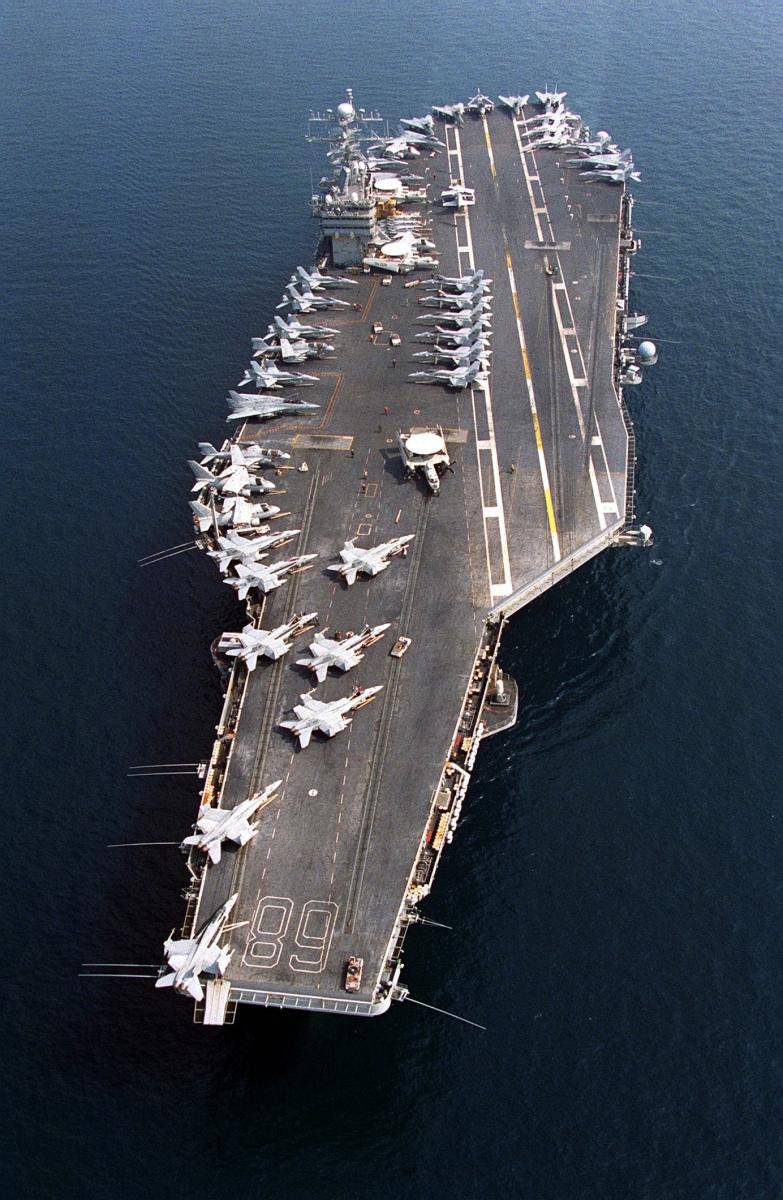
Nimitz, top view. Hiking configuration; there are no on-duty duty machines on the deck, the landing strip is blocked, only 3 and 4 catapults can work on the lift. You can clearly see the tight placement of cars on the pre-launch position SIXPACK. If necessary, they can be lifted in the air in 45-50 minutes.
The aircraft carrier "Harry Truman" class "Nimitz" inside the order of protection. The setting is obviously relaxed. There is not a single aircraft on the deck, which would take less than an hour to get into the air, it is possible to use only one catapult and aircraft cannot be received. Judging by the number of people on the deck, some kind of party is expected. On deck, 3 Amphibious machines and a pair of EW aircraft are visible.
The launch cycle duration for aircraft carriers of the Nimitz class is usually from one to one and a half hours and, obviously, depends on the number of aircraft being raised, weather conditions, the number of operational launches, etc. In some cases (difficult weather conditions, difficult movement on deck, inability to use all prelaunch positions, use of abnormal prelaunch positions, etc.) the duration of one cycle can approach the 2-m clock, but should not exceed this value. The maximum duration of the startup cycle is dictated by safety regulations. In the 2-hour cycle, by the time the last produced aircraft leaves the aircraft carrier, the first take-off is already waiting for landing, and the take-off operations are stopped in order to clear the landing strip, which also does not happen instantly. Thus, the interval at which aircraft takes off on aircraft carriers varies, on average, from 3-x to 6-minutes [5]. This, of course, is much more than the claimed advertising characteristics in 20 seconds. The 20-second interval is theoretically attainable only when the attendant takes off from the state of immediate readiness in good weather - the regulations limit the take-off interval in conditions of poor visibility and low cloud cover.
Simultaneous take-off of 2-x F / A-18E from the deck of "George Washington". Obviously, the teachings. Another plane is preparing for takeoff. A distinctive cuff after takeoff is well visible.
"Harry Truman" raises aircraft. The landing strip is blocked, the 1 and 4 catapults are used, the third one is also free. One fighter is in immediate readiness for takeoff; EW machine and fighter in 5-10 minute and one more in 15-minute readiness. The degree of readiness of the rest of the machines to assess this photo is difficult. The aircraft are being trained on the 2 th catapult path, ammunition is being taken to the vehicles aft. Flight operations are conducted with low intensity, as evidenced by the use of abnormal pre-launch positions. Probably, we are witnessing a shock operation - this is indicated by the EW machines prepared for departure and a relatively tight turn for takeoff. In this case, half of the machines placed on the flight deck do not participate in this operation.
Can an aircraft carrier lift all the wing in one launch cycle? Technically, yes, although this is a hard-wearing job. But at the same time, the duration of such a cycle will exceed the safety standards. Thus, this case involves the withdrawal of the wing to the shore, one way. In terms of assessing the combat power of the ship, consideration of this mode of operation is not of interest.
Why is the startup cycle so long? After all, if all the machines assigned to the combat mission are on the flight deck, then any of them is theoretically ready for an hour or so. If the machines would fly into the air faster, this would also increase their number from the maximum 20 to a higher number. In addition, the deck area, it would seem, allow you to prepare cars for take-off and in non-standard positions.
In fact, the use of abnormal prelaunch positions dramatically reduces the speed of preparation of machines for departure. The deck of the aircraft carrier is designed in such a way that the elevators of the ammunition assembly are located near the standard pre-launch positions, and there are all the necessary infrastructure for refueling and pre-launch checks. Delivery of ammunition to emergency positions takes considerable time, and the number of mobile means of mechanization is obviously limited. Thus, the preparation for the departure of the car at a non-standard position takes hardly twice as long - those same hours and a half instead of the standard 45 minutes. The maximum number of aircraft in one launch cycle implies the use of all available resources for training. At the same time, the capacity of the standard pre-launch positions is 12 machines - this is the squadron of the first echelon, which can be in the air in the first 45 minutes.
Takeoff F / A-18F from the deck of the aircraft carrier Abraham Lincoln. The pre-launch position is the track of the second catapult (the catapult is counted from right to left). 9 machines are placed on the pre-launch position, two of which (2-i and 3-i in depth) probably passed pre-launch checks and are preparing to be towed to the start line. One can see carts with ammunition for equipment. Takeoff is made with low intensity. Highlighted coloring machine leader of the second link (fourth in depth). The second link is represented by newer F / A-18E and F machines, the third one has a mixed composition.
In modern conditions, the US Navy aircraft carriers operate under complete domination at sea. In this situation, the regulations in force during the Cold War are more and more relaxed. In real operations, where ensuring the maximum speed of lifting machines is not a priority, it is increasingly practiced to prepare machines in non-standard positions, long launch cycles and preparation for departure. Placing cars on the flight deck also becomes the rule rather than the exception. Despite the fact that such a placement makes it difficult to take off work with maximum intensity and exposes open cars to additional danger in the event of accidents on the deck and fire impact, the convenience of unhurried board manipulation without unnecessary fuss with elevators is put at the center.
F-14 take-off from the deck of the aircraft carrier Theodore Roosevelt. A relatively clean deck creates a feeling of relaxed work, but in fact we are seeing just the rise of aircraft with maximum intensity. All 4 catapults are used; three aircraft have just taken off, three more are on 5-minute readiness and the fourth is being flown at the start. The absence of extra cars on the deck and free paths of movement to start-ups ensure the maximum launch speed.
"Ronald Reagan" in the sea. Almost empty flight deck is typical for long crossings and when operating in adverse weather conditions.
So far, we have been considering flight operations on US Navy aircraft carriers. Carriers of other countries use similar preparation procedures for launch, but the flight deck has been zoned differently. Here stands the ships of the class "Kuznetsov." For pre-launch preparation of aircraft they have a continuous zone surrounding the superstructure. Preparing cars for departure involves blocking elevators, but does not use the landing strip area (if there is no need to use a long start). In the prelaunch training zone, without prejudice to the work of the ship to receive aircraft, two links can be placed. This characteristic is exactly the same as that of the “Nimitsev” subject to the conditions of simultaneous work on take-off and reception of aircraft. Although the absence of a third elevator at the stern limits Kuznetsov’s ability to receive machines in one pair - then it will be necessary to clear the space by rotating the aircraft in the training zone and freeing access to the aft elevator. The launch cycle of the two links in both aircraft carriers will have a similar duration, despite the fact that the Kuznetsov is technically unable to ensure the simultaneous take-off of two aircraft. This is compensated for by the increased speed of setting the machines at the start (no fastening on the catapult is required) and by the rapid alternation of starts.
Kuznetsov in the sea, clean deck. Visible area of preparation of machines for departure, limited red dotted markings around the superstructure.
Technically, Kuznetsov-class aircraft carriers, using the landing strip areas as a non-standard pre-launch position, can prepare a full squadron for takeoff. But this mode of operation is not used in practice. Here, a rather poor tradition of aircraft carrier exploitation by the fleet of Russia is affecting. The standards of flight operations are observed more strictly, and the “improvisation” in the use of the area of the flight deck, typical for the US Navy, is hardly possible. Another purpose of an aircraft carrier also manifests itself initially: first of all, the fleet air cover ship, and not the means of conducting shock operations against the coast. In this role, the superiority of the “Nimitz” to the “Kuznetsov” is primarily manifested in the presence in the wing of the DRLO aircraft, and not in the number of aircraft. The quality of the fighter cover provided by the US Navy aircraft carriers is comparable. Here, the role is not so much the number of cars in one launch cycle (it is more important for carrying out percussion operations), but rather the line of patrols of duty units.
Kuznetsov in the sea. On the deck there are two links; the second uses square aft elevator. The short duty start pair is probably in 15-minute readiness. Please note that the landing strip is not blocked. The deck configuration allows it to be used simultaneously with both short starts.
A couple of Kuznetsov's short starts. The photo is most likely staged - air intake plugs are visible.
The aircraft carrier of the “De Gaulle” class demonstrates a compromise approach, and according to the characteristics of the wing and the launch cycle organization it is similar to the ships of the “Kuznetsov” class. It also uses two starts, working with alternation, and the number of machines in 45-minute readiness is the same two links, plus a couple at the start. In solving the tasks of the aviation cover of the fleet, “De Gaulle” is somewhat superior to the “Kuznetsov” due to the presence of DRLO aircraft in its composition. At the same time, the launch cycle of the duty team at De Gaulle will be somewhat longer due to the use of the ejection method of take-off. “De Gaulle” is able to hold more aircraft on deck without using the elevator area, which is primarily due to the smaller geometric dimensions of the wing wings. The area occupied on the deck of large Su-33 class machines is much larger.
"De Gaulle" view from above. The flight deck looks almost empty. Two "Rafal", the link "Super Etandarov" and the DRLO aircraft are in minimal readiness. The helicopter is either preparing to take off, or has just landed.
"De Gaulle", clearly staged parade photo. The entire wing is placed on the flight deck, the DRLO machines demonstrate readiness for launch. Despite the staged nature of the picture, it can be assumed that, if necessary, the rise of the squadron will take no more than an hour.
"De Gaulle" against the background of "Abraham Lincoln." A DRLO aircraft with folded wings in a half-hour (or more) readiness takes the start of the first catapult. Preparing the rest of the machines for takeoff will take longer. On the deck there are two links, the area of both elevators is not occupied, the landing strip is blocked.
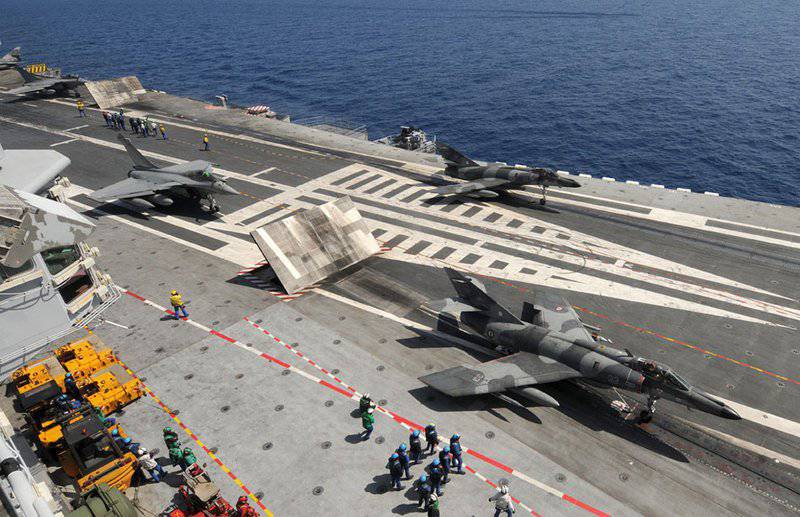
"De Gaulle" makes lifting machines. Two "Super Etandar" take off, a pair of "Rafale" in 5-minute readiness.
INTERIM CONCLUSIONS
The superiority of the Nimitz class ships over any other aircraft carriers of the world is undeniable. Particularly vividly it manifests itself in solving shock problems. Of the modern aircraft carriers, only the Nimitsy are able to lift into the air a balanced strike force, which will include the strike squadron, a covering group and support vehicles. Some classes of machines that are necessary to successfully accomplish percussion tasks (primarily specialized EW aircraft) are simply absent from the aircraft wing of aircraft carriers of other countries. A significant role in maintaining this superiority also has a rich tradition of aircraft carrier operation and accumulated experience of their combat use. As we, we hope, managed to demonstrate, the US Navy, taking advantage of domination at sea, use their aircraft carriers quite naturally, often relaxing the standards for conducting operations in favor of the convenience of operating the wing.
At the same time, the advertised prohibitive combat power of American aircraft carriers turns out to be a myth. Declared in the characteristics of 90 aircraft wing machines spend most of the time on the coast, being assigned to the aircraft carrier only formally. The 20-second takeoff interval in practice turns out to be the 5-minute. The maximum volume of the raised air group is no more than 20 machines, or rather one shock squadron with attached flight support equipment. The rise of this compound into the air takes more than one and a half hours, which means that it is impossible to use the full combat load. At least the first 6 vehicles in the launch cycle are forced to use outboard tanks in order to operate in conjunction with planes taking off later at the same range. From a tactical point of view, this means that the range of the strike connection can never reach its theoretical maximum, and the combat load will be at best half of the declared in the characteristics of the aircraft.
Here you can jokingly propose the rule of "dividing by two" in relation to American aircraft carriers. Wing? Divide 90 into two, and you’ll get a realistic figure - 36 machines on the hangar deck and two links on the flight, if the weather permits. Startup cycle? We divide by two the number of vehicles that the aircraft carrier actually carries on board - the correct figure will be obtained. Combat radius? Divide by two. Combat load? We use the same approach.
Propaganda and PR in the modern world order are, perhaps, even more important than the actual combat power of the ship. The Nimitz class aircraft carrier is a very powerful means of force projection. And the image that was created around him in the information field is stronger many times over. Try searching on the Internet for photographs of aircraft carriers - you will see a large number of beautiful “grand” pictures with a full wing on the deck. These photographs are most often taken during and after joint exercises. But to find pictures of the real combat work of an aircraft carrier is much more difficult, partly because they look far less impressive.
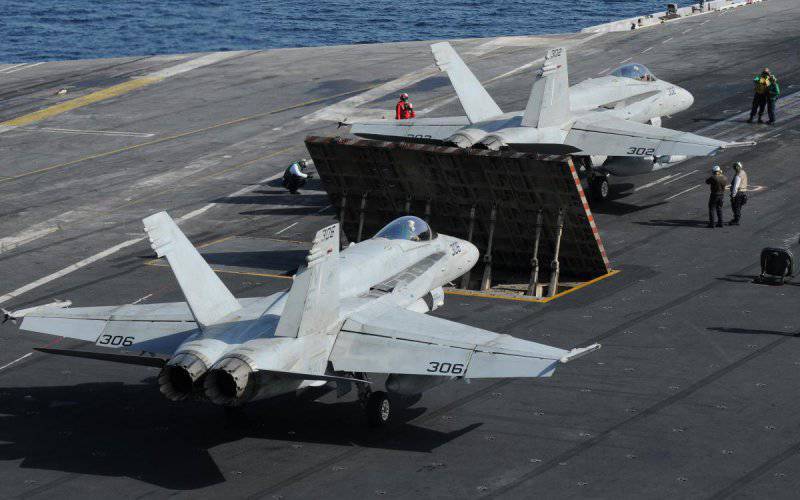

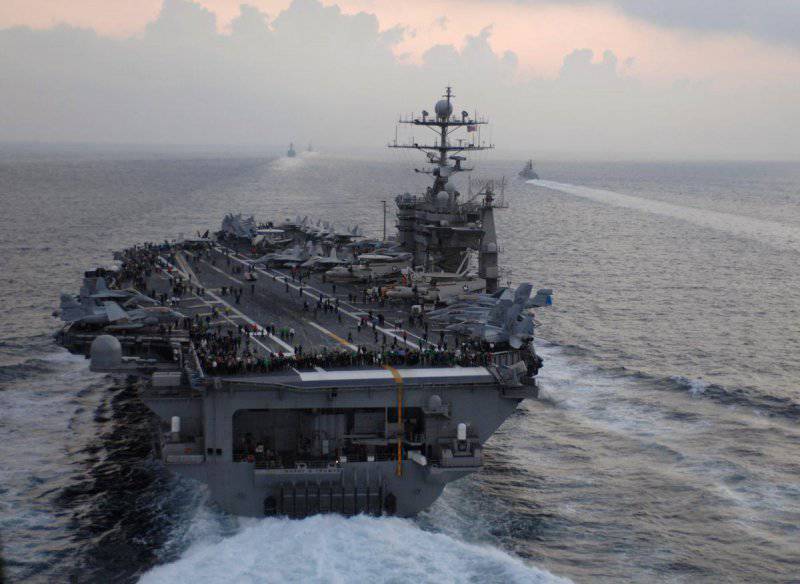
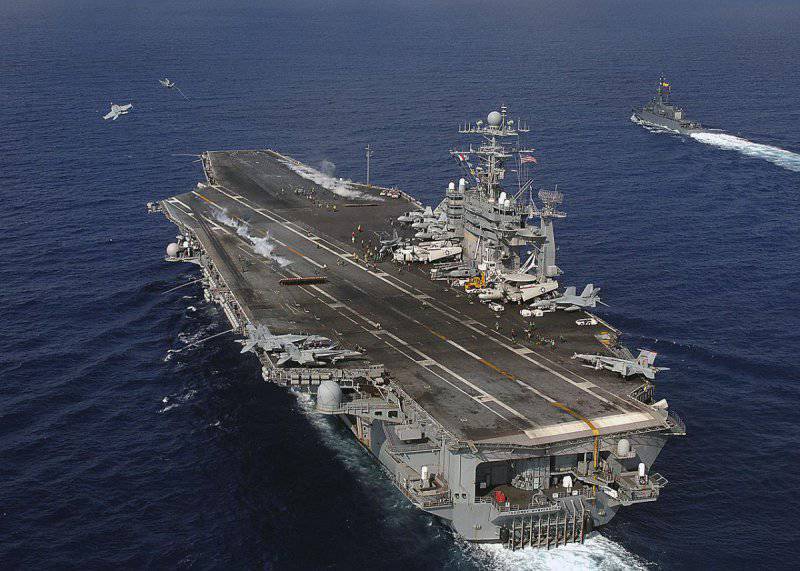
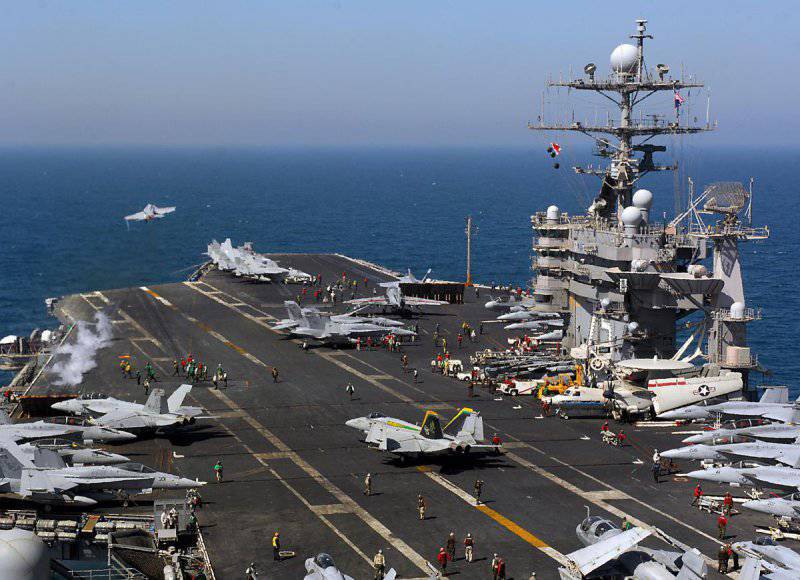
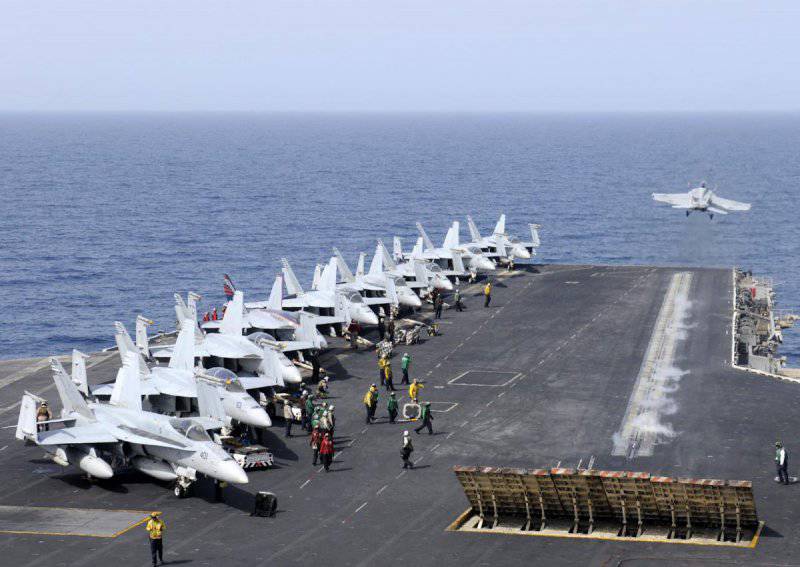
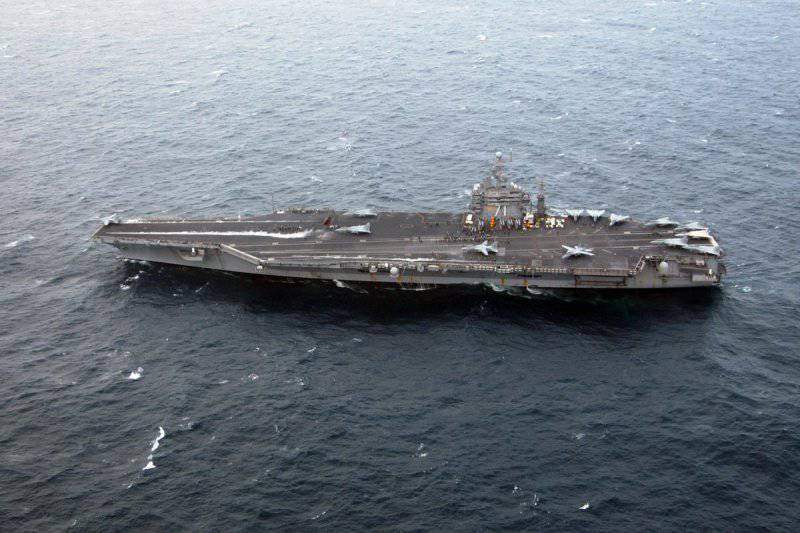
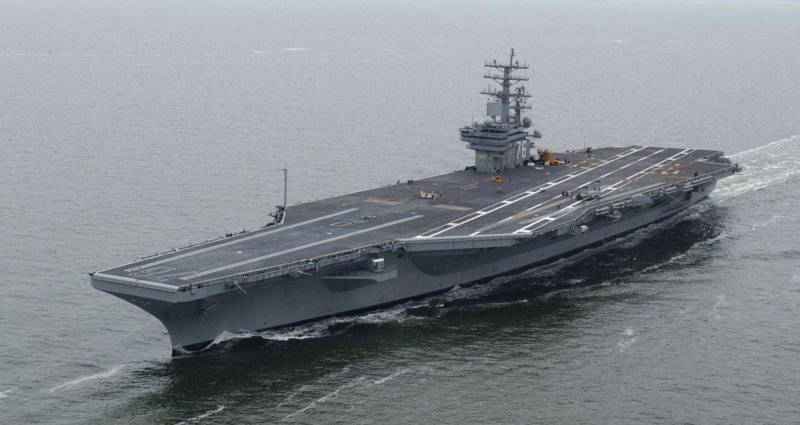
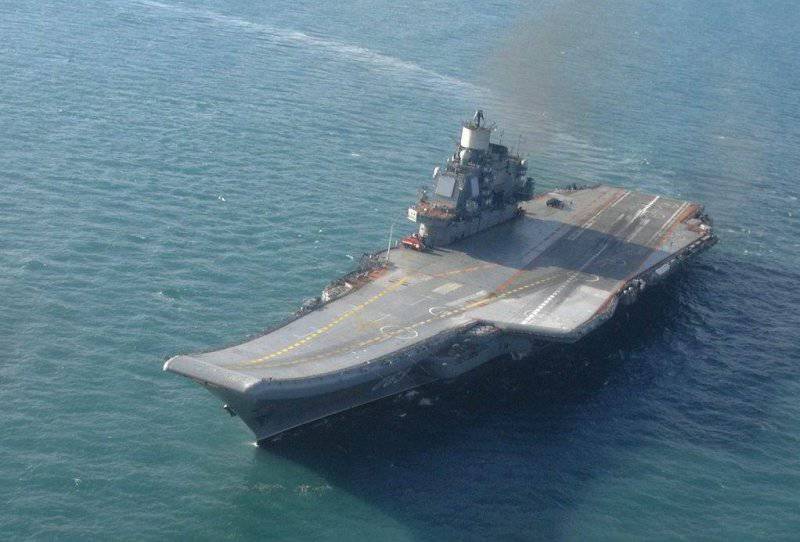
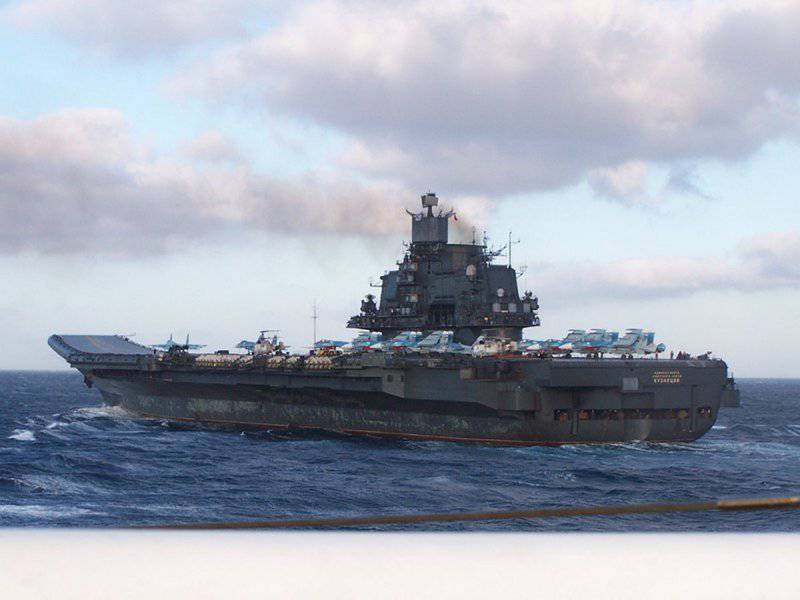
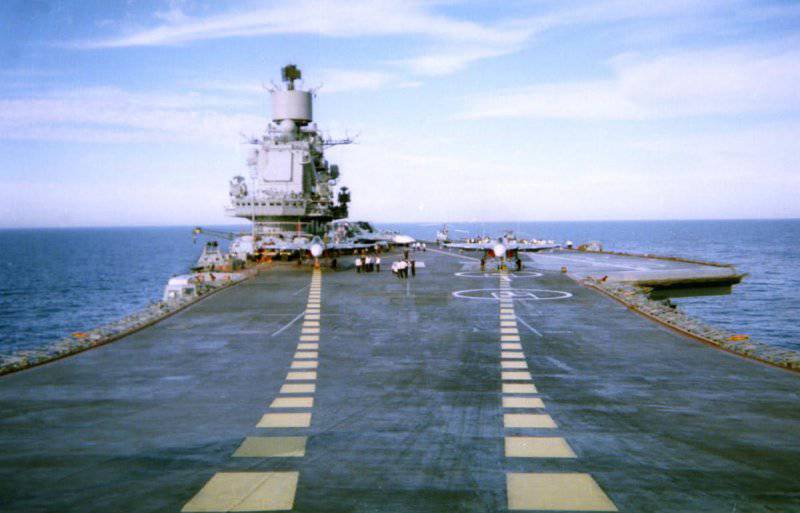
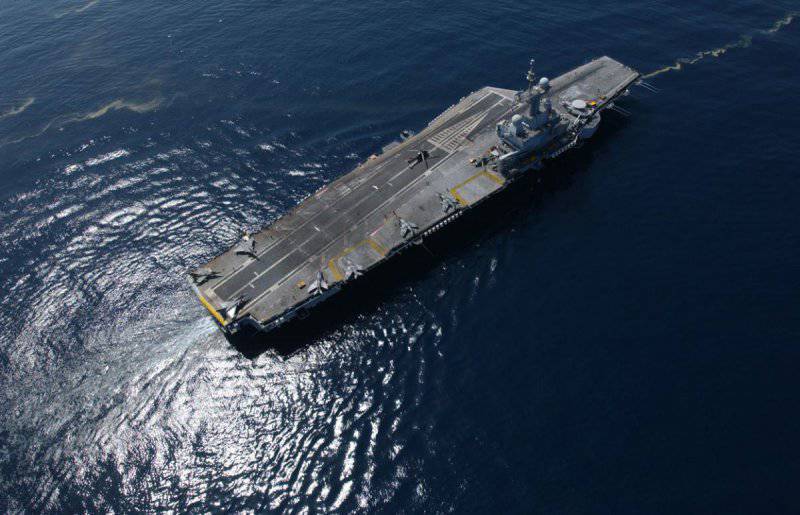
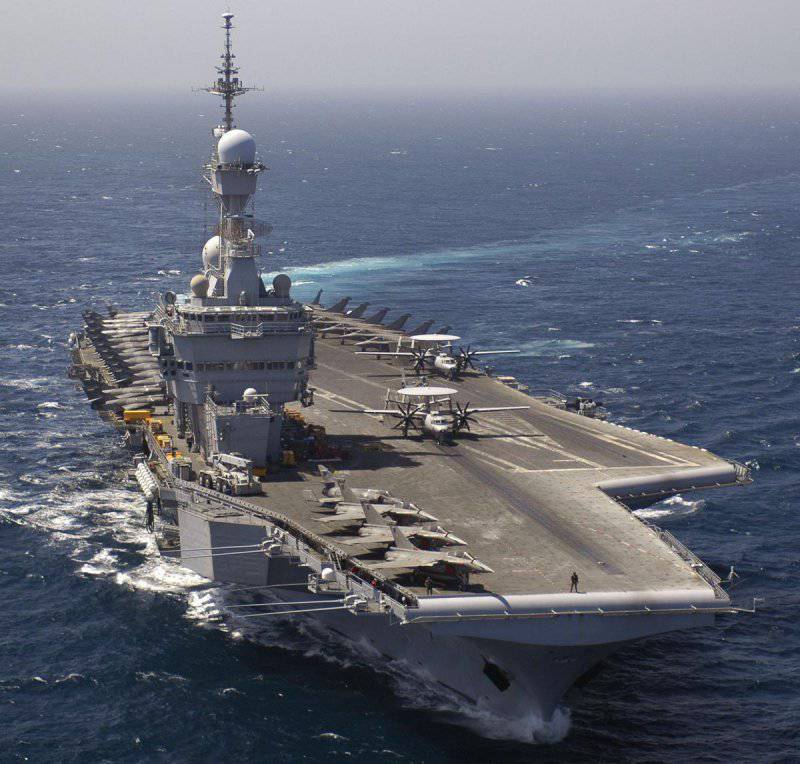
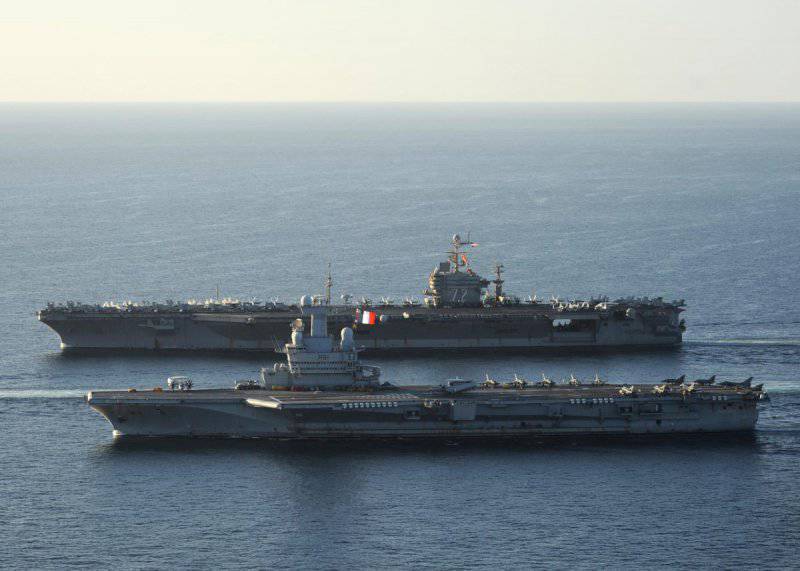
Information